1.10: Inheritance
- Page ID
- 24257
Introduction:
(Adapted from http://www2.le.ac.uk/departments/gen...itancepatterns)
In diploid organisms, each body cell (or 'somatic cell') contains two copies of the genome. So each somatic cell contains two copies of each chromosome and two copies of each gene. The exceptions to this rule are the sex chromosomes that determine sex in a given species. For example, in the XY system that is found in most mammals—including human beings—males have one X chromosome and one Y chromosome (XY) and females have two X chromosomes (XX). The paired chromosomes that are not involved in sex determination are called autosomes, to distinguish them from the sex chromosomes. Human beings have 46 chromosomes: 22 pairs of autosomes and one pair of sex chromosomes (X and Y).
The different forms of a gene that are found at a specific point (or locus) along a given chromosome are known as alleles. Diploid organisms have two alleles for each autosomal gene: one inherited from the mother, one inherited from the father.
Mendelian Inheritance Patterns:
Within a population, there may be a number of alleles for a given gene. Individuals that have two copies of the same allele are referred to as homozygous for that allele; individuals that have copies of different alleles are known as heterozygous for that allele. The inheritance patterns observed will depend on whether the allele is found on an autosomal chromosome or a sex chromosome, and on whether the allele is dominant or recessive.
If the phenotype associated with a given version of a gene is observed when an individual has only one copy, the allele is said to be autosomal dominant. The phenotype will be observed whether the individual has one copy of the allele (is heterozygous) or has two copies of the allele (is homozygous).
If the phenotype associated with a given version of a gene is observed only when an individual has two copies, the allele is said to be autosomal recessive. The phenotype will be observed only when the individual is homozygous for the allele concerned. An individual with only one copy of the allele will not show the phenotype but will be able to pass the allele on to subsequent generations. As a result, an individual heterozygous for an autosomal recessive allele is known as a carrier.
Scientists use a grid-like tool (Punnett Square) to make predictions about various genetic problems. The Punnett Square shows only the probability (the chance of something occurring) of what might occur and not the actual results. For example, if one wants to flip a coin 100 times, since there are 2 sides to the coin, he would expect 50 heads and 50 tails. If he flips the coin 100 times, he may actually get 60 heads and 40 tails. Punnett Square only shows the chances of what might occur each time the event is undertaken.
Note
It doesn't matter how often you flipped a coin or how many times it's already shown heads, the probability is ALWAYS 50% of heads/tails. For example, if I've tossed a coin 4 times and all four times it came up heads. What is the probability that my next toss will be heads?
Part 1: Simulating a Monohybrid Cross
(Adapted from http://extension.uga.edu/k12/science...nettSquare.pdf Science Behind Our Food, the National Science Foundation and the University of Georgia)
Procedure:
1. Each group will pick up 2 paper bags filled with 15 red (R) beans and 15 white (r) beans. This represents 2 heterozygous parents (Rr x Rr).
2. At the same time, each student will reach into their bag and pull out one of the beans. The only possibilities that can be made from this selection are: RR (homozygous red), Rr (heterozygous red), or rr (homozygous white). Mark the resulting genotype and phenotype in the data table.
3. Return the beans back into the bag and conduct the same process 14 more times (15 total trials).
Data Table:
| Trial | Offspring Genotype | Offspring Phenotype |
| 1 | ||
| 2 | ||
| 3 | ||
| 4 | ||
| 5 | ||
| 6 | ||
| 7 | ||
| 8 | ||
| 9 | ||
| 10 | ||
| 11 | ||
| 12 | ||
| 13 | ||
| 14 | ||
| 15 |
Questions:
1. What is the dominant trait?
a. How do you know it is dominant?
2. What is the recessive trait? Male __________ x Female __________
3. What are the genotypes of the parents? 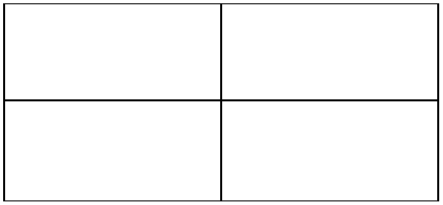
4. What are the phenotypes of the parents?
5. Fill in the Punnett Square on the right using the parents given in the procedure:
6. What is the genotypic ratio?
7. What is the phenotypic ratio?
Part 2: Dihybrid Crosses—Crosses That Involve 2 Traits.
(Adapted from http://www.biologycorner.com/bio2/ge..._dihybrid.html)
These can be challenging to set up, and the square you create will be 4x4. This simple guide will walk you through the steps of solving a typical dihybrid cross common in genetics. The method can also work for any cross that involves two traits.
Consider this cross:
A pea plant that is heterozygous for round, yellow seeds is self-fertilized; what are the phenotypic ratios of the resulting offspring?
Step 1: Determine the parental genotypes from the text above, the word "heterozygous" is the most important clue, and you would also need to understand that self-fertilized means you just cross it with itself. When choosing letters to represent your genes, you’ll need to choose one letter per characteristic. If it is dominant it will be capitalized and if it is recessive it will be lower case.
RrYy x RrYy
Step 2: Determine the gametes. This might feel a little like the FOIL method you learned in math class. Combine the R's and Ys of each parent to represent sperm and egg. Do this for both parents:

Gametes after "FOIL": RY, Ry, rY, ry (parent 1) and RY, Ry, rY, ry (parent 2)
Step 3: Set up a large 4x4 Punnet square, place one gamete set from the parent on the top, and the other on the side. Refer to the figure on the following page.
Step 4: Write the genotypes of the offspring in each box and determine how many of each phenotype you have. In this case, you will have 9 round, yellow; 3 round, green; 3 wrinkled, yellow; and 1 wrinkled green.
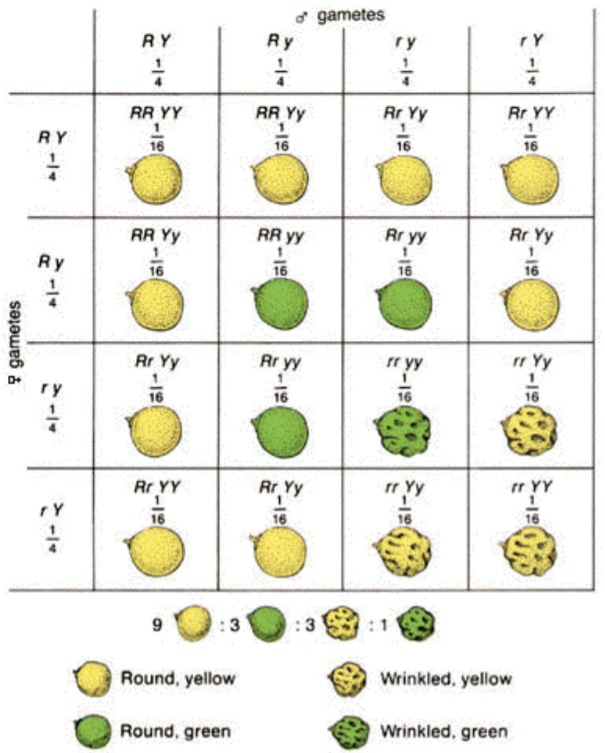
Some Shortcuts:
In any case where the parents are heterozygous for both traits (AaBb x AaBb), you will always get a 9:3:3:1 ratio.
9 is the number for the two dominant traits, 3 is the number for a dominant/recessive combination, and only 1 individual will display both recessive traits.
Another way to determine the ratios is to do it mathematically \(\frac{3}{4}\) of all the offspring will have round seeds \(\frac{3}{4}\) of all the offspring will have yellow seeds \(\frac{3}{4} * \frac{3}{4}\) = \(\frac{9}{16}\) will have round, yellow seeds.
Crosses That Involve 2 Traits:
Consider: RrYy x rryy
The square is set up as shown below.
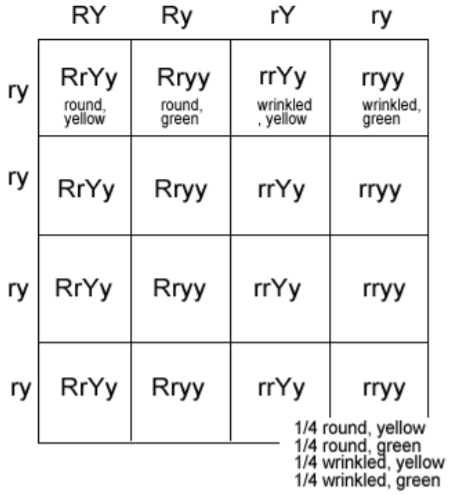
You might notice that all four rows have the same genotype. In this case, you really only need to fill out the top row, because \(\frac{1}{4}\) is the same thing as \(\frac{4}{16}\).
Additional problems:
In rabbits, grey hair is dominant to white hair. Also in rabbits, black eyes are dominant to red eyes. 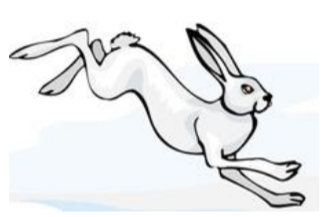
- GG = gray hair
- Gg = gray hair
- gg = white hair
- BB = black eyes
- Bb = black eyes
- bb = red eyes
1. What are the phenotypes of rabbits that have the following genotypes:
Ggbb ____________________ ggBB ________________________
ggbb ____________________ GgBb _________________________
2. A male rabbit with the genotype GGbb is crossed with a female rabbit with the genotype ggBb The square is set up below. Fill it out and determine the phenotypes and proportions in the offspring.
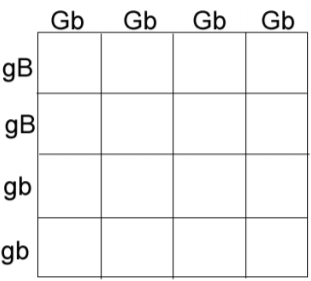 How many out of 16 have grey fur and black eyes? ________
How many out of 16 have grey fur and black eyes? ________
How many out of 16 have grey fur and red eyes? ________
How many out of 16 have white fur and black eyes? ________
How many out of 16 have white fur and red eyes? ________
3. A male rabbit has the genotype GgBb. Determine the gametes produced by this rabbit (the sperm would have these combinations of alleles).
4. Use the gametes from #3 to set up a Punnett square below. Put the male's gametes on the top and the female's gametes down the side. Then, fill out the square and determine what kind of offspring would be produced from this cross and in what proportion.
5. An aquatic arthropod called a Cyclops has antennae that are either smooth or barbed. The allele for barbs is dominant. In the same organism, resistance to pesticides is a recessive trait. Make a "key" to show all the possible genotypes (and phenotypes) of this organism. Use the rabbit key to help you if you're lost. 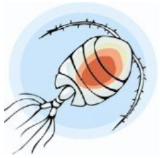
6. A Cyclops that is resistant to pesticides and has smooth antennae is crossed with one that is heterozygous for both traits. What are the genotypes of the parents?
7. Set up a Punnett square for the cross and show the phenotypic ratios.
Part 3: Sex-linked or X-linked inheritance
(Adapted from http://www.biologycorner.com/workshe...s_xlinked.html)
In many organisms, the determination of sex involves a pair of chromosomes that differ in length and genetic content - for example, the XY system used in human beings and other mammals.
The X chromosome carries hundreds of genes, and many of these are not connected with the determination of sex. The smaller Y chromosome contains a number of genes responsible for the initiation and maintenance of maleness, but it lacks copies of most of the genes that are found on the X chromosome. As a result, the genes located on the X chromosome display a characteristic pattern of inheritance referred to as sex-linkage or X-linkage.
Females (XX) have two copies of each gene on the X chromosome, so they can be heterozygous or homozygous for a given allele. However, males (XY) will express all the alleles present on the single X chromosome that they receive from their mother, and concepts such as 'dominant' or 'recessive' are irrelevant.
A number of medical conditions in humans are associated with genes on the X chromosome, including hemophilia, muscular dystrophy and some forms of color blindness.
1. In fruit flies, eye color is a sex-linked trait. Red is dominant to white. What are the sexes and eye colors of flies with the following genotypes?
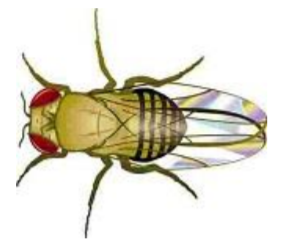
XRXr ________________ XRY ________________ XrXr ________________
XRXR________________ XrY________________
2. What are the genotypes of these flies:
white-eyed, male ____________ red-eyed female (heterozygous) ________
white-eyed, female ___________ red-eyed, male ___________
3. Show the cross of a white-eyed female XrXr with a red-eyed male XRY.
4. Show a cross between a pure red-eyed female and a white-eyed male.
What are the genotypes of the parents?
How many of the offspring are:
white-eyed, male ______ white-eyed, female ______ red-eyed, male ______ red-eyed, female ______
5. Show the cross of a red-eyed female (heterozygous) and a red-eyed male.
What are the genotypes of the parents?
How many of the offspring are:
white-eyed, male ______ white-eyed, female ______ red-eyed, male ______ red-eyed, female ______
6. In humans, hemophilia is a sex-linked trait. Females can be normal, carriers, or have the disease. Males will either have the disease or not (but they won’t ever be carriers).
XHXH = female, non-hemophilic XHY = male, non-hemophilic
XHXh = female, carrier
XhXh = female, hemophiliac XhY= male, hemophiliac
Show the cross of a man who has hemophilia with a woman who is a carrier.
What is the probability that their children will have the disease? _____________
7. A woman who is a carrier marries a non-hemophilic man. Show the cross. What is the probability that their children will have hemophilia? What sex will a child in the family with hemophilia be?
8. A woman who has hemophilia marries a non-hemophilic man. How many of their children will have hemophilia, and what is their sex?
9. In cats, the gene for calico (multicolored) cats is both sex-linked and codominant. Due to a phenomenon known as dosage compensation, females that receive a B and an R gene have black and orange splotches on white coats. Males can only be black or orange, but never calico.
What would a calico cat’s genotype be?
Show the cross of a female calico cat with a black male.
What percentage of the kittens will be black and male? _________
What percentage of the kittens will be calico and male? _________
What percentage of the kittens will be calico and female? _________
10. Show the cross of a female black cat with a male orange cat. What percentage of the kittens will be calico and female? What color will all the male cats be?
Part 4: Incomplete Dominance and Codominance
Some heterozygotes express a phenotype that is intermediate between the dominant and recessive phenotype. For example, in 4 o’clock flowers, the gene for red pigmentation is dominant and the gene for white pigmentation is recessive. However, heterozygotes are pink. The dominant allele does not completely mask the expression of the recessive allele: it is incompletely dominant.
1. By observing the flower color of 4 o’clock flowers, is it possible to unambiguously determine the genotype? (YES/NO)
Is the same true for flower color in snow peas? (YES/NO) Why or why not?
Another inheritance pattern of note is that of codominance. Here, both alleles for the same characteristic can be expressed. A common example of this is human A B O blood type. The alleles for the surface antigens are both dominant; the allele for no surface antigen is recessive.

2. If two individuals with blood type AB marry, what are the odds that each of their children will have the AB blood type?
3. A disputed paternity case! Hermione’s new baby has a blood type of O. Her blood type is B and Ron Weasley’s is A. Harry Potter (blood type AB) insists he is the child’s father. CAN THIS BE TRUE?


